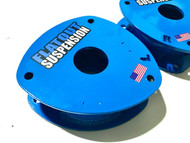Can you combine lift spacers with Flatout GR coilovers?
Posted by Flatout Tech on Sep 27th 2024
We get asked often, "Can I use spacers on top of the GR suspension?"
While the answer is yes, it's a "yes" with several caveats. Yes, they fit, but...
Your typical strut/ shock top spacer is put in place to increase the length of the OEM assembly which effectively pushes the suspension down to give you a lift equal to the height of the spacer. A 1" spacer adds 1" of length to the OEM suspension assembly and that gives you a 1" lift.
Our GR suspension is manufactured with an assembly length greater than the OEM assembly by 1-2" so in simplest terms, it's equivalent to an OEM assembly paired with a 1-2" spacer (depending on the application). At near zero preload, just installing without setting anything but perch height, you should have a 2" lift right from the onset of installation (results may vary).
If you add a 2" spacer to the GR, it would be the same as adding a 4" spacer to an OEM assembly. That's a lot of lift. Maybe too much for what you want. If you only wanted 2" of lift; if you pair a GR with a 2" top spacer, your only way to counter the extra 2" is to unload the suspension by introducing negative preload, or with a GR Light, adjusting the bracket at the hub to make the assembly shorter - thus making the spacer a paperweight.
So let's talk about the counter-measures you have to do and you'll see why adding a spacer is counter-productive.
If your GR suspension has 8" of total stroke (travel). At zero preload, you should have a sag rate of 3" leaving you with 5" of upward travel (not including the bumpstop, so really 3.5-4" of net travel). Lets say you have added a 2" spacer atop the GR, you're ready to set ride height and you have the 4" lift mentioned above without doing anything. Now you need to take away 2" of your total lift (assuming a 2" top spacer). You have to take that travel from the spring perch (negative preload), so when you unload 2" to achieve a 2" lift, that leaves you with 1.5-2" of upward travel. Alternatively, you take 2" from the lower mount bracket, thus canceling out the 2" spacer you added (it's now back to standard GR assembly length).
In some cases, your lower arm can only swing down so far before it hits it's geometrical limit (arm binding on the subframe). If you add a spacer that allows it to max out and then some, you have to compress the shock assembly to bolt the strut to the hub - your assembly is too long and you will never be able to use that length. In fact, you will have to compress the shock just to fit - you take that again from upward travel.
If you go through all of this...adding the GR, adding the 2" spacer, using counter-measures to drop from 4" of lift - your ride will be terrible because you'll be on the bumpstops with the slightest dip, you'll have noises going over bumps, and you'll be chasing your tail constantly trying to resolve the issues that follow.
If you have maxed out the GR and have 1/2" to 1" of available room, that is the maximum sized spacer you should use. In most cases, a 1/2" spacer is all that will reasonably fit.
So yes, you can use a spacer, but only equivalent to the remaining geometry of the arm. If you are looking to lift no more than 3", you likely won't need to pair it with a spacer. Our generally GR is more than capable of 3".
Questions?
TLDR; don't use a spacer lift unless you want something like a minimum of 4 inches of lift.

